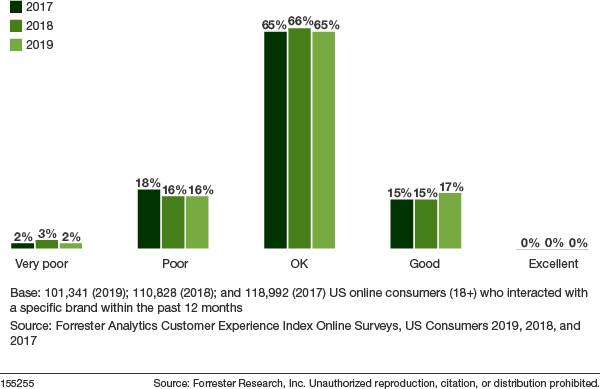
CX is hard. That’s the main takeaway from Forrester’s 2019 US Customer Experience Index (CX Index), an annual survey of more than 100,000 US customers examining the CX performance of 260 brands in 16 industries.
The good news: 14% of brands included in the survey saw a significant bump in their score this year, and only 5% saw a decline. However, 81% saw their scores stuck, with many industry front-runners reclaiming the top spot.
In his analysis of the report, Forrester’s Rick Parrish says the CX landscape is suffering from “widespread stagnation,” with many companies failing to improve their score. Parrish also highlighted how there are “no real leaders” in CX — not a single company that has topped the rankings managed to continue to improve.

Sadly, the 2019 CX Index is very consistent with the last few years, which also found that improvements in experiences have stagnated.
The lack of meaningful improvements in CX is alarming given the high correlation between CX performance and higher revenue. A recent study from Adobe found that companies with more mature CX practices tend to have stronger business performance. Organizations that are “very advanced” in their CX are over 3.5 times more likely to exceed their business goals, according to the study.
In recent years, touting customer experience has also been trendy with business leaders. Gartner’s latest CMO Spend Survey found that CX was top of mind for marketing leaders, with almost 20% of marketing budgets going to CX initiatives. The results of this year's CX Index suggest, however, that all this talk isn't translating into action.
According to Annette Franz, founder and Chief Experience Officer of CX Journey Inc. and contributor to Forbes, mediocrity is widespread in CX because — ironically enough— of the wide availability of technology.
“I’ve heard too many executives say that they are implementing this or that technology to fix the experience, but that’s not the answer,” Franz shared. “You still have to understand customer needs and jobs to be done — and figure out how technology can facilitate that within the grand scheme of things. But don't slap the latest and great tech on a problem and assume it's fixed."
You still have to understand customer needs and jobs to be done.
Eileen Campbell, Executive Chair at Reid Campbell Group, agrees that technology can sometimes hinder — rather than improve — the customer experience. “In some ways, technology almost legislates against building emotional connections. While we all appreciate the efficiency of a great tech interaction, these don’t always engender the warmth and emotional connection that comes with a great human interaction.”
In some ways, technology almost legislates against building emotional connections.
To Eileen’s point, creating the right emotions is an important but often-ignored factor. Forrester’s research shows that how an experience makes customers feel has a bigger influence on brand loyalty than other factors such as effectiveness or ease.
In an effort to differentiate on CX, many companies are investing in uncovering experience data — the sentiments, attitudes and emotions of customers that transactional data can’t reveal. However, the way companies gather experience data is often antiquated.
As Andrew Reid, our CEO and Founder, pointed out in a recent blog post, the main way companies gather experience data is through email-based surveys — an outdated approach that has fallen out of favor with consumers. To make things worse, traditional surveys tend to be clunky (especially on mobile devices) and too clinical and formal, which results to a not-so-great experience.
“Whether you like it or not, your customer surveys are an extension of your brand,” Andrew writes. “A subpar survey experience not only reflects badly on your company — it also leads to inaccurate data. Surveys need to provide a much better respondent experience than they do now. If the industry doesn’t improve how it engages with customers, people will refuse to participate in research, which will in turn impact the quality of your data."
A subpar survey experience not only reflects badly on your company—it also leads to inaccurate data.
Experience data has the potential to reveal the authentic emotions of customers and their unmet needs — insights that will help drive CX transformation. But to unlock the potential of this data, companies need to re-examine the way they capture it.
Tech and data are important, but in the end, companies need to establish foundational CX elements to drive meaningful change. According to Franz, this includes making sure that the employee experience is not an afterthought. She recommends going beyond the “soft stuff” like growth, development and career planning, and tackling the more tangible elements like training and processes.
Finally, companies need to ensure decision-makers do something about the data and insights they have on hand. “Make sure you have executive commitment for, and alignment around, the journey,” said Franz. “Take an outside-in perspective; deliberately design a customer-centric culture where you give customers a seat at the table, in every decision you make. Listen to and understand customers, and act on what you hear.”
Subscribe to our blog to receive the latest news, trends and best practices from market research experts.


No Comments Yet
Let us know what you think